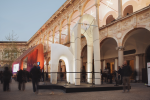ZHA and Vertico Unveil Aevum, a Hybrid Marble and 3D Printed Arch in Milan
At the 2025 INTERNI ‘Cre-Action’ exhibition held at the Università degli Studi di Milano, London architecture firm Zaha Hadid Architects (ZHA) and Dutch 3D concrete printing specialist Vertico presented Aevum, a collaborative installation that explores the intersection of historical stone carving and robotic concrete 3D printing.
Aevum, meaning “eternity” in Latin, consists of two offset arches measuring 6 by 6 meters. One arch is carved from solid marble; the other was produced using Vertico’s large-scale 3D concrete printing system. The 3D printed arch comprises 21 unique elements, stands 5.6 meters tall, weighs 5.5 tons, and was printed over six days. Installation was completed in seven days, with structural and fabrication support provided by Carpenterie Pezzetti and Eckersley O’Callaghan.
“This project is a real milestone,” said Volker Ruitinga, CEO of Vertico. “It establishes the legitimacy of 3D printed concrete by juxtaposing it with established marble craftsmanship. The speed, low cost, form freedom, and short delivery times promised by additive manufacturing are showcased here.”
The Aevum structure consists of two staggered arches measuring 6 x 6 meters. Photo via Vertico.
Material Development and Circular Design Focus
The printed structure was fabricated using Vertico’s Accelerator printhead mounted on a robot-on-track platform. A custom Sika cement mix enabled the production of non-planar geometries and large overhangs required by ZHA’s design. The printing process prioritized design accuracy within a compressed timeline.
In addition to form and technique, the installation incorporates waste-based material use. Marble dust—generated as a by-product of the stone processing industry—was used in the 3D printable concrete. This aligns with Zaha Hadid Architects’ ongoing research into circular material systems and additive manufacturing.
“It is with good reason that the courtyard of the Università degli Studi di Milano is admired to this day, making it the ideal backdrop for this architectural conversation,” said Volker Ruitinga, CEO of Vertico.
3D printing of an arch structure. Photo via Vertico.
How 3D Printing Is Impacting Arts and Sculptures
3D printing technology is increasingly being used to preserve and reproduce cultural heritage, from ancient artifacts and relics to new sculptures and monuments. This month, as part of London’s Natural History Museum (NHM) 150th anniversary celebrations, a new gallery has opened showcasing the ‘Fixing Our Broken Planet’ exhibition. The exhibition display cases were created in collaboration with the NHM’s in-house team and LAMÁQUINA, a Barcelona-based 3D design and manufacturing studio, using 3D printed ceramics incorporating recycled clay and biopolymer joints. The gallery was restored to preserve its Victorian features while integrating sustainable design and materials, in line with the Museum’s commitment to innovation and heritage conservation.
In 2022, researchers at University College London (UCL) combined X-ray imaging, artificial intelligence, and 3D printing to recreate a lost painting by Vincent Van Gogh titled The Two Wrestlers. Working with artist Jesper Eriksson, the team used X-rays to examine paint layers beneath an existing canvas. The data was then processed using an AI algorithm trained on Van Gogh’s style, producing a 3D model that reflected the missing artwork.
Who won the 2024 3D Printing Industry Awards?
Subscribe to the 3D Printing Industry newsletter to keep up with the latest 3D printing news.
You can also follow us on LinkedIn, and subscribe to the 3D Printing Industry Youtube channel to access more exclusive content. shows Featured imagethe Aevum structure consists of two staggered arches measuring 6 x 6 meters. Photo via Vertico.


